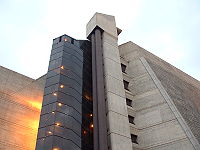- Teresa Carreño Cultural Complex
-
Coordinates: 10°29′56″N 66°53′52″E / 10.4990°N 66.8978°E
Teresa Carreño Cultural Complex Complejo Cultural Teresa Carreño 

Address Final Avenida Paseo Colón, Los Caobos City Caracas Country  Venezuela
VenezuelaArchitect Tomás Lugo Marcano , Jesús Sandoval & Dietrich Kunckel Capacity 2900 Opened April 19, 1983 www.teatroteresacarreno.gob.ve The Teresa Carreño Cultural Complex (Complejo Cultural Teresa Carreño), also known as Teresa Carreño Theater (Teatro Teresa Carreño), is the most important theatre of Caracas and Venezuela, where performances include symphonic and popular concerts, opera, ballet and plays. It is the second largest theater in South America after the Teatro Colón of Buenos Aires.
The theatre was built on a 22 thousand square meter lot and named after the Venezuelan pianist Teresa Carreño. It is located in the cultural district of the city near the Caobos Park and the building that was occupied by the Caracas Athenaeum up to 2009. It houses two concert halls: the José Félix Ribas and the Ríos Reyna.
It is the residence of
- the Teresa Carreño Opera Choir ,
- the Teresa Carreño Ballet, directed up to 2002 by renown choreographer Vicente Nebrada,
- the National Philarmonic Orchestra of Venezuela.
Its spaces are also shared by the National Theater Company of Venezuela, the Monteávila bookstore and the Venezuela's Cinematheque Video Shop.
The artistic director of the theater is the Venezuelan conductor Rodolfo Saglimbeni.
 Ballet Giselle, directed by the Prima Ballerina Assoluta Alicia Alonso.
Ballet Giselle, directed by the Prima Ballerina Assoluta Alicia Alonso.
Contents
History
In the 1970s, Pedro Antonio Ríos Reyna presented a plan to build a theatre to serve as the residence of the Venezuela Symphony Orchestra. The Simón Bolivar Center expanded the project so that the center would serve multiple uses.
The funds for construction were granted in September 1970, and the architects were Tomás Lugo, Jesús Sandoval, and Dietrich Kunckel.
The theatre was inaugurated in two phases: the José Félix Ribas Hall in February 1976, followed by the Ríos Reyna Hall and the rest of the complex on 19 April 1983.
The center facilities have been expanded with two exhibition halls, one dedicated to the pianist Teresa Carreño and another one to the composer Reynaldo Hahn.
Spaces
The Teresa Carreño Theatre is an architectonical and cultural masterpiece of Venezuela. It covers a surface of 22,586 m² and has a completed area of over 80,000 m².
Enormous columns and hexagonal roofs in an harmonic overlaid position, integrate the majestic expression of joint architecture and pluralist nature, making it a unique theatre.
- The Ríos Reyna Hall holds 2,400 people. It is the stage for symphonic concerts, operas, and the most important ballet company of the city.
- The José Félix Ribas Hall was designed for symphonic and chamber music. Given its intimacy, it could be described as a studio space. It takes the form of a Greek semicircular theatre, a space of 507.5 square meters, a lobby of 160 square meters and capacity for 440 people. It was the official building of the Orquesta Sinfónica Simón Bolívar (Venezuela's youth orchestra) from 1976 until the opening of the Inter-American Center for Social Action through Music in 2007.[1]
Artwork
The Theater has extraordinary decoration, with fine pieces of artwork.
- There are some major master pieces from the Venezuelan sculptor Jesús Rafael Soto: white vibrant cubes on yellow projection (in the ceiling of the entrance of the Ríos Reyna Hall), vibrant Buckets on white and black progression (in the parking, in front of the José Félix Ribas Hall), vibrant Pyramids (acoustic ceiling of the José Félix Ribas Hall), black Scripture on white bottom and fire-resistant drop curtain (drop curtains of the Ríos Reyna Hall).
- Pedro Basalo created the Bust of Teresa Carreño located in Cellar 1 area.
- Harry Abend developed the Relief mural on inclined screens (in the troncopiramidal peak of the scene of the Ríos Reyna).
- There are also major artist with presence in the Cultural Complex, such as Erling Oloe, Colette Dellozane, Jorge Pizzani and Vincenzo Gemito.
See also
References
- ^ Ed Vulliamy (29 July 2007). "Orchestral manoeuvres". The Guardian. http://observer.guardian.co.uk/magazine/story/0,,2133790,00.html. Retrieved 2007-09-01.
External links
Landmarks of Caracas Museums Alejandro Otero Museum · Bolivarian Museum · Simón Bolívar birthplace house · Simón Bolívar Center · Children's Museum · Fine Arts Museum · La Estancia Art Center · National Gallery of Art · National Pantheon of Venezuela · Science Museum · Soto SphereReligion Culture and sport Teresa Carreño Cultural Complex · Poliedro de Caracas · Municipal Theater · National Theater · La Rinconada Hippodrome · University City · University Stadium · Brígido Iriarte StadiumOther Parque Central Complex · National Library of Venezuela · Parque del Este · Los Caobos Park · El Silencio · La Pastora · Plaza Bolívar · Plaza Francia · El Calvario · Los Próceres Monument · Plaza Venezuela · Plaza Alfredo Sadel · Humboldt Hotel · Nuevo Circo · Federal Capitol · Miraflores Palace · La Casona · Yellow House · Supreme Tribunal of Justice · Quinta de Anauco · Palace of the Academies · Carmelitas Post Office · Los Conductores del País Mural · Villa Planchart · Caracas Metro · Caracas Aerial Tramway
Categories:- Buildings and structures completed in 1983
- Concert halls
- Theatres in Venezuela
- Buildings and structures in Caracas
- Caracas
- Event venues established in 1983
Wikimedia Foundation. 2010.







